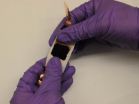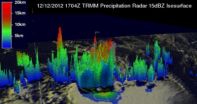(Press-News.org) Electronic devices become smaller, lighter, faster and more powerful with each passing year. Currently, however, electronics such as cell phones, tablets, laptops, etc., are rigid. But what if they could be made bendable or stretchy?
According to the University of Delaware's Bingqing Wei, stretchable electronics are the future of mobile electronics, leading giants such as IBM, Sony and Nokia to incorporate the technology into their products.
Beyond traditional electronics, potential stretchable applications include biomedical, wearable, portable and sensory devices, such as cyber skin for robotic devices and implantable electronics.
"Advances in soft and stretchable substrates and elastomeric materials have given rise to an entirely new field," says Wei, a mechanical engineering professor at UD.
But even if scientists can engineer stretchable electronics – what about their energy source?
"Rechargeable and stretchable energy storage devices, also known as supercapacitors, are urgently needed to complement advances currently being made in flexible electronics," explains Wei.
Wei's research group at the University is making significant progress in developing scalable, stretchable power sources for this type of application using carbon nanotube macrofilms, polyurethane membranes and organic electrolytes.
This, he says, requires new thinking about materials processing and device manufacturing to maximize energy storage without compromising energy resources.
To reveal a stretchable supercapacitator's true performance, the Wei group examined the system's electrochemical behavior using buckled single-wall nanotube (SWNT) electrodes and an elastomeric separator.
According to Wei, the supercapacitor developed in his lab achieved excellent stability in testing and the results will provide important guidelines for future design and testing of this leading-edge energy storage device.
As they work to refine the technology, Wei has filed a provisional patent to protect his team's research. The work was recently published in Nano Letters, a journal of the American Chemical Society.
INFORMATION:
Stretchable electronics
UD professor works to develop power sources for flexible, stretchable electronics
2012-12-15
ELSE PRESS RELEASES FROM THIS DATE:
Drug to treat opioid addiction poses risks for accidental exposure to children
2012-12-15
(SALT LAKE CITY)—Buprenorphine is a safe and effective drug for treating opioid addiction. But as the prescribed use of buprenorphine has dramatically increased in recent years, accidental exposure of children to the drug has risen sharply, placing them at risk for serious injury and in extremely rare cases even death, according to researchers at the Utah Poison Control Center (UPCC), U School of Medicine's Department of Family and Preventive Health, and the Utah Department of Health (UDOH).
In a study published Thursday, Dec. 13, 2012, by the U.S. Centers for Disease ...
NASA sees Tropical Cyclone Evan batter and drench Samoan Islands
2012-12-15
NASA's Tropical Rainfall Measuring Mission or TRMM satellite continues to provide rainfall and cloud height data on powerful Cyclone Evan as it crawls through the Samoan Islands with hurricane-force winds and heavy rains. NASA's TRMM satellite identified "hot towers" in the storm, hinting that it would continue to intensify.
On Dec. 14, American Samoa, Tonga and Fiji are all under warnings or alerts as Evan continues to move west. A gale warning is in effect for Tutuila and Aunuu. A high surf warning is in effect for all of American Samoa. A flash flood watch is in effect ...
In decision-making, it might be worth trusting your gut
2012-12-15
Turns out the trope is true: You should trust your gut -- as long as you're an expert. So says a new study from researchers at Rice University, George Mason University and Boston College.
"How expert someone is within a particular domain has a positive impact on their ability to make an accurate gut decision," said Rice's Erik Dane, lead author of a study published last month in the journal Organizational Behavior and Human Decision Processes. However, he added, "Even if you're an expert, intuitive decision-making is better for some types of tasks than others. Tasks that ...
Dreidel-like dislocations lead to remarkable properties
2012-12-15
HOUSTON – (Dec. 14, 2012) – A new material structure predicted at Rice University offers the tantalizing possibility of a signal path smaller than the nanowires for advanced electronics now under development at Rice and elsewhere.
Theoretical physicist Boris Yakobson and postdoctoral fellow Xiaolong Zou were investigating the atomic-scale properties of two-dimensional materials when they found to their surprise that a particular formation, a grain boundary in metal disulfides, creates a metallic – and therefore conducting – path only a fraction of a nanometer wide.
That's ...
We're all living longer, but longevity increases not benefitting everybody
2012-12-15
TORONTO, ON – Global lifespans have risen dramatically in the past 40 years, but the increased life expectancy is not benefitting everybody equally, say University of Toronto researchers. In particular, adult males from low- and middle-income countries are losing ground.
People are living longer on average than they were in 1970, and those extra years of life are being achieved at lower cost, the researchers, led by U of T Chemical Engineering PhD candidate Ryan Hum, say in a paper published in the open access science journal eLife this month.
However, the costs for ...
The HER2 paradox: HER2-positive stem cells found in HER2-negative breast cancer
2012-12-15
(SACRAMENTO, Calif.) — A multicenter study led by researchers at UC Davis describes new, paradoxical characteristics of the most common type of breast cancer. The findings shed light on how the disease can evade treatment and could improve diagnosis and treatment of breast cancer.
The research, led by Jian Jian Li, director of translational research in the UC Davis Department of Radiation Oncology, examined breast tumors previously thought to lack the HER2 protein, which, when over-expressed, is associated with disease recurrence. Instead, researchers found in the tumors ...
UCLA engineers develop new energy-efficient computer memory using magnetic materials
2012-12-15
By using electric voltage instead of a flowing electric current, researchers from UCLA's Henry Samueli School of Engineering and Applied Science have made major improvements to an ultra-fast, high-capacity class of computer memory known as magnetoresistive random access memory, or MRAM.
The UCLA team's improved memory, which they call MeRAM for magnetoelectric random access memory, has great potential to be used in future memory chips for almost all electronic applications, including smart-phones, tablets, computers and microprocessors, as well as for data storage, ...
A drug used to treat HIV might defuse deadly staph infections
2012-12-15
A new study by NYU School of Medicine researchers suggests that an existing HIV drug called maraviroc could be a potential therapy for Staphylococcus aureus, a notorious and deadly pathogen linked to hundreds of thousands of hospitalizations each year. Their study is published online this week in Nature.
"What are the chances that a drug for HIV could possibly treat a virulent Staph infection?" asks Victor J. Torres, PhD, assistant professor of microbiology, and senior author of the study. "These findings are the result of a fantastic collaboration that we hope will result ...
Ibrutinib has 'unprecedented' impact on mantle cell lymphoma
2012-12-15
ATLANTA - An international study of ibrutinib in people with relapsed or refractory mantle cell lymphoma (MCL) continues to show unprecedented and durable results with few side effects.
Researchers from The University of Texas MD Anderson Cancer Center presented interim findings of the multi-center Phase 2 study today at the 54th American Society of Hematology Annual Meeting and Exposition.
"I believe we are witnessing a breakthrough in mantle cell lymphoma. This is great news for patients," said Michael Wang, M.D., associate professor in MD Anderson's Departments of ...
If you cut down a tree in the forest, can wildlife hear it?
2012-12-15
BOZEMAN, MT (December 13, 2012) – A new tool developed by the Wildlife Conservation Society (WCS) and its partners is being used by scientists and land managers to model how noise travels through landscapes and affects species and ecosystems— a major factor in land and wildlife management decisions such as where to locate new roads or recreational trails.
The tool, SPreAD-GIS, uses spatial data layers to predict how sound spreads from a source through the surrounding landscape and how it is affected by such factors as vegetation, terrain, weather conditions, and background ...
LAST 30 PRESS RELEASES:
Scientists use ultrasound to soften and treat cancer tumors without damaging healthy tissue
Community swimming program for Black youth boosts skills, sense of belonging, study finds
Specific depressive symptoms in midlife linked to increased dementia risk
An ‘illuminating’ design sheds light on cholesterol
Who is more likely to get long COVID?
Study showcases resilience and rapid growth of “living rocks”
Naval Research Lab diver earns Office of Naval Research 2025 Sailor of the Year
New Mayo-led study establishes practical definition for rapidly progressive dementia
Fossil fuel industry’s “climate false solutions” reinforce its power and aggravate environmental injustice
Researchers reveal bias in a widely used measure of algorithm performance
Alcohol causes cancer. A study from IOCB Prague confirms damage to DNA and shows how cells defend against it
Hidden viruses in wastewater treatment may shape public health risks, study finds
Unlock the power of nature: how biomass can transform climate mitigation
Biochar reshapes hidden soil microbes that capture carbon dioxide in farmland
Reducing saturated fat intake shows mortality benefit, but only in high-risk individuals
Manta rays create mobile ecosystems, study finds
Study: Mixed results in using lipoic acid to treat progressive multiple sclerosis
Norbert Holtkamp appointed director of Fermi National Accelerator Laboratory
New agentic AI platform accelerates advanced optics design
Biologists discover neurons use physical signals — not electricity — to stabilize communication
Researchers discover that a hormone can access the brain by hitchhiking
University of Oklahoma researcher awarded funding to pursue AI-powered material design
Exploring how the visual system recovers following injury
Support for parents with infants at pediatric check-ups leads to better reading and math skills in elementary school
Kids’ behavioral health is a growing share of family health costs
Day & night: Cancer disrupts the brain’s natural rhythm
COVID-19 vaccination significantly reduces risk to pregnant women and baby
The role of vaccination in maternal and perinatal outcomes associated with COVID-19 in pregnancy
Mayo Clinic smartwatch system helps parents shorten and defuse children's severe tantrums early
Behavioral health spending spikes to 40% of all children’s health expenditures, nearly doubling in a decade
[Press-News.org] Stretchable electronicsUD professor works to develop power sources for flexible, stretchable electronics




